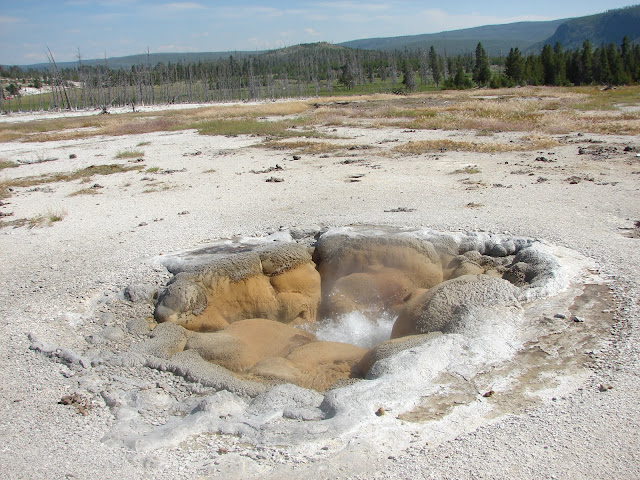Yellowstone is an active super-volcanic park and boasts a grand display of vivid geothermal features, perhaps the only one of its kind in the world. As noted on the park website, it's home to more than 10,000 features of which more than 300 are geysers. With all its spectacular flora, fauna, and natural wonders, this park has been given a deserving place in the list of UNESCO World Heritage sites.
 |
| West Thumb Geyser Basin |
The geothermal features in the park are:
Hot springs: Hot Springs are formed when superheated groundwater surfaces into a wide pool without any constrictions in its plumbing system. The hot water cools down on reaching the surface and gets replaced by hotter water from below and this cycle continues till someday the water depletes from the ground reservoir or there are constrictions formed in the passage which results in the formation of fumaroles or geysers.
Geysers: Geysers are Hot Springs with constrictions in the passage of groundwater rising to the surface. The constrictions, usually near the surface, prevent the water from circulating freely. The hot water fails to cool and high-pressure steam is formed below the surface which eventually explodes outwards in the form of a geyser. Water is expelled faster than it can enter the geyser's plumbing system, and the heat and pressure gradually decrease. The eruption stops when the water reservoir depletes or when the system cools down.
Fumaroles: Fumaroles or steam vents, occur in openings like cracks and fissures in volcanic regions when superheated water (with temperatures as high as 280 F (138 C) vaporizes before reaching the surface due to a drop in pressure or due to the short supply of water in the underground reservoir. Steam and other gases often toxic emerge from the vent, with hissing and whistling sounds similar to a pressure cooker.
Mudpots: Mudpots are acidic hot springs or fumaroles. Microorganisms convert hydrogen sulfide, rising from the depths of the earth into sulphuric acid, which breaks down surrounding rocks into clay thus forming a muddy acidic bubbling pot.
Travertine Terraces: Travertine Terraces are staggered terrace-like formations, formed from limestone or calcium carbonate deposited by the water flowing from the hot springs.
Microbial Mats and Thermophiles: Microorganisms called thermophiles (heat lovers) or extremophiles (lovers of extremity), inhabit the volcanic regions. These microorganisms when clustered together in millions form microbial mats. These microbial mats contribute to the colors of the geothermal features. An article explaining this phenomenon.
So, our third visit to Yellowstone was during a fall, long weekend after a year of our second visit. We planned to fly to Jackson Hole, Wyoming, and then drive down to the park through the South gate via Grand Teton National Park.
Must mention, the flight landing in Jackson Hole is one of the most spectacular I have ever seen. It's a big regret that I was too mesmerized to click a photo or take a video :(
While the oblivious 'me' was gazing aimlessly out of the aircraft window, the flight in gradual descent emerged out of the dense cottony veil of clouds, swept smoothly down through a sky passage between two snow-peaked mountains into the lap of a green grassy bowl surrounded by a tall majestic range. An unforgettable stupendous experience.
The tiny but busy airport of Jackson Hole is located amidst the breathtaking Teton range and that makes it one of those exclusive airports with the most beautiful flight landings. Anyone visiting Jackson Hole must take the flight experience at least once.
We stayed in Jackson Hole for a day and I thoroughly enjoyed its picturesque locale. The hole part of the name is quite apt. The town, indeed is located in a hole between the mountains. It is a small, cozy, laid-back, peaceful town with a lively downtown and lots of fun stuff.
Early next morning, we drove down to Yellowstone National Park. The scenic drive took almost a couple hours. On the way, we stopped at a viewpoint at Grand Teton National Park, the Jackson Lake Dam and Reservoir, and Lewis Lake. The glimpse of Grand Teton National Park was quite impressive and we were tempted to hang around longer but Yellowstone was our primary destination and we had to curb our detour having made the promise to come back later for the Teton experience.
We stayed at a lodge in Yellowstone Park for the next two days. On the fourth day, we flew out of Jackson Hole to our respective destinations. All three of my Yellowstone visits were short weekend trips and that definitely did no justice. There's lots to do, and lots to see, and it's never enough.
Three Seasons in Yellowstone National Park - Winter - North gate >> Part 1
Must mention, the flight landing in Jackson Hole is one of the most spectacular I have ever seen. It's a big regret that I was too mesmerized to click a photo or take a video :(
While the oblivious 'me' was gazing aimlessly out of the aircraft window, the flight in gradual descent emerged out of the dense cottony veil of clouds, swept smoothly down through a sky passage between two snow-peaked mountains into the lap of a green grassy bowl surrounded by a tall majestic range. An unforgettable stupendous experience.
The tiny but busy airport of Jackson Hole is located amidst the breathtaking Teton range and that makes it one of those exclusive airports with the most beautiful flight landings. Anyone visiting Jackson Hole must take the flight experience at least once.
 |
| Flight take off at Jackson Hole airport |
We stayed in Jackson Hole for a day and I thoroughly enjoyed its picturesque locale. The hole part of the name is quite apt. The town, indeed is located in a hole between the mountains. It is a small, cozy, laid-back, peaceful town with a lively downtown and lots of fun stuff.
Early next morning, we drove down to Yellowstone National Park. The scenic drive took almost a couple hours. On the way, we stopped at a viewpoint at Grand Teton National Park, the Jackson Lake Dam and Reservoir, and Lewis Lake. The glimpse of Grand Teton National Park was quite impressive and we were tempted to hang around longer but Yellowstone was our primary destination and we had to curb our detour having made the promise to come back later for the Teton experience.
 |
| Jackson Dam |
 |
| Lewis lake |
 |
| Geysers submerged in Yellowstone Lake |
 |
| Fishing cone geyser (inactive) |
One of my favorite destinations in the park is the lake. It is absolutely gorgeous and I can just sit at the beach for hours doing nothing but gazing and daydreaming :) and I really did that for a while.
Some fascinating features around the lake are the submerged pools and geysers like the fishing cone. 'The name Fishing Cone can be traced back to tales told by mountain men of a lake where you could catch a fish then immediately dunk it into hot spring and cook it on the hook.' - source: Wikipedia.
I was told, that in the early 20th century, the park visitors could actually fish trouts in the lake and then cook them in the hot spring but since 1911, this activity has been strictly prohibited. Visitors started clogging the vents of the geysers and springs and disturbed their ecological system. Well, cooking may not be allowed today but canoeing, kayaking, and boating are and are popular activities in the park.
Some fascinating features around the lake are the submerged pools and geysers like the fishing cone. 'The name Fishing Cone can be traced back to tales told by mountain men of a lake where you could catch a fish then immediately dunk it into hot spring and cook it on the hook.' - source: Wikipedia.
I was told, that in the early 20th century, the park visitors could actually fish trouts in the lake and then cook them in the hot spring but since 1911, this activity has been strictly prohibited. Visitors started clogging the vents of the geysers and springs and disturbed their ecological system. Well, cooking may not be allowed today but canoeing, kayaking, and boating are and are popular activities in the park.
 |
| The Grand Canyon of Yellow Stone |
 |
| Brink of Upper Falls |
 |
| Brink of lower falls |
The Grand Canyon of Yellowstone is another popular attraction of Yellowstone. There are many hiking trails around the area leading to the two falls and the Yellowstone River at the canyon base. We were short on time but still managed a couple of short hikes. Animal sighting during this visit was limited to the usual herds of bison and elks. I think one needs to camp around the valleys and rivers for better animal sightings. Next time.... next time :) Thankfully there's always a next time :)
 |
| The lake meets the spring |
Three Seasons in Yellowstone National Park - Summer - East gate >> Part 2

































